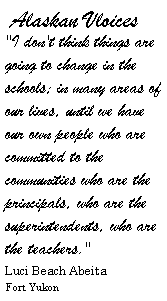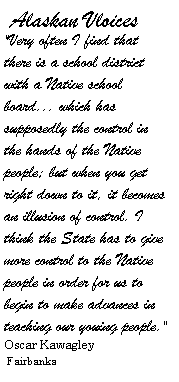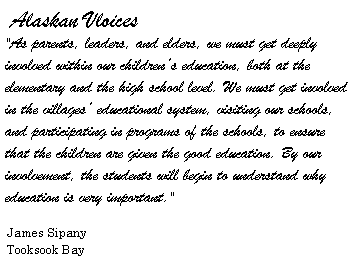| Recommendation 1. The State of Alaska should assist local residents in predominantly Native areas of the state to further establish local control of schools by recasting advisory boards as policymaking boards and by enabling, over a five-year period, the Regional Education Attendance Area (REAA) system to delegate the authority for schools to tribal governments in partnership with the Alaska Department of Education. Discussion The Native community, including parents and community leaders, needs to achieve a compelling voice in the direction of the formal education system. In village Alaska, Natives must assume true "ownership" of the schools. New forms of empowerment in this critical area need to be appreciably different than what exists today. Natives should not be relegated to the role of just electing local advisory school boards. Those advisory boards that do exist should be policymaking boards with control over hiring, curricula, and educational program plans, at a minimum. Alaska Native villages must be willing to actually take over control and direction of their schools and school systems, even if it means having to create the smallest and poorest school districts in the nation to achieve it. And the State must be willing to make changes in policies and in the system to facilitate true local Native control. A tribal government entering into a partnership with the Alaska Department of Education as an alternative to participation in the REAA system should be required to participate in the funding of the school to the same extent as similarly situated Alaskan municipalities operating local school systems. Tribal governments unable to meet this financial obligation, if any, should be provided federal financial assistance through special appropriations to the Bureau of Indian Affairs for such purposes. Recommendation 2. The State of Alaska and local school districts need to markedly increase the number of Native teachers and administrators to meet the particular needs of Alaska Native students through affirmative hiring, alternative certification, and other means. Discussion In most schools in predominantly Native
communities, The personnel in rural schools must be equipped to take advantage of Native ways of learning. And they need to understand who Native children are, the social environments in which those children live, and the culture of the family and community. The importance of Native teachers and administrators as role models for Alaska Native students, many of whom have low self-esteem and fatalistic outlooks on life, is another crucial aspect that needs to be clearly recognized and appreciated by Alaska’s educational system. The cultural gap between Native children and their teachers has narrowed, but the chasm that has existed for a century is still unacceptably wide. It must finally be bridged. The Alaska Legislature can do its part by resisting the political pressures that have held it immobile on this issue for far too long. Recommendation 3. The Congress and the State of Alaska should help to increase social and cultural linkages between schools and the villages by creating an Alaska Native Heritage Trust, the funds from which would be granted to Alaska Native tribes for (1) programs to develop parent and village government involvement in the schools and school systems;. and, (2) use in schools and villages for enhancing Native languages and cultures. Discussion Notwithstanding the relatively recent
construction of modern school facilities in most Native
communities throughout the state, these educational
institutions fall far short of pro Also critical to the educational success of Alaska Native children is an integrated education, one that gives them the skills that will lead to success in life as well as the understanding that will continue the community’s values. An integrated education will give children both Native and Western values so that they are empowered in both cultures. The skills and values are inseparable, for mastery of one cannot be obtained without mastery of the other. Native children need to know, understand, and be comfortable with who they are as members of distinct races and cultures. The burden for ensuring that this happens rests firmly on the shoulders of Native people. But the schools, with important roles to play in the development of children, must share the responsibility together with families and community members. |
Native to Native Attempting to understand why Native children are at or near the bottom of academic achievement charts is a topic of concern and debate for parents, educators, and policymakers alike. Certainly, some of the emerging arguments and theories have merit, and some of the remedies that have been tried have improved various aspects of the educational system for Alaska Native children. There have been many changes in curricula. Multimillion dollar schools have been built in virtually every village in the state. Rural school districts with Native board members have been created. But the fact remains: Native children are still not learning.
Having ceded the responsibility of educating Alaska Native children to missionaries and territorial school teachers during the early part of this century, most Native families and villages have never reassumed that responsibility. Consequently, education is now perceived as being someone else’s job. Native villages and their governments remain, if not disinterested, then certainly disengaged with respect to schools and the school systems in which their children are immersed.
In order to fully understand the current situation, it must be understood that, in spite of the long history of attempted acculturation of Alaska Native peoples and tribes, Alaska Natives remain culturally different from the rest of Alaska and the United States. In other words, the ideas, methods, and languages used to teach Native children are still alien and, therefore, still difficult for students to grasp.
Transferring information and ideas from one culture to another is complex. Among Alaska Natives, the social and economic conditions of the families and villages make educational success even more difficult. Many children come from homes where there is chronic abuse of alcohol and the frightening reality of family violence. They come from homes that have a near-total dependence on government for economic survival. Many of these homes are steeped in spiritual and economic poverty where the parents and other family members are too preoccupied with their own problems to pay adequate attention to the child and how he is doing in school.
All too often, the school is a place of rest for a child who does not sleep well and does not get the nurturing she needs at home. The school, then, is a place not for learning but instead a place to temporarily escape the less than fortunate realities of home. These children — distracted by problems in the home and village — will not learn. Without doubt, this is one of the major reasons why Alaska native children are not learning in school. The problems of village and home are robbing them of their most receptive and inquisitive years . . . their childhoods.
Government must bear some of the blame and responsibility for the inadequacy of the formal education being delivered, or not delivered, to Alaska Native children. But Native villages and families are responsible, too. While many Native parents and extended family members might themselves lack the formal Western educational grounding to teach the children algebra, chemistry, grammar, and the like, they can certainly give active and positive support to their children and the teachers. They can look after the nutritional needs of their children, and they can make sure they are getting enough rest. In many cases, they also have the tools and the knowledge to teach their children the Native language, history, and traditions. They can help the children understand who they are as members of distinct cultures. Though Native societies and cultures have gone through transformations from the ancient ones, Alaska Native people still stand as the best conduits through which education of young Natives can be successfully realized.
|
 there remains an entirely inadequate
representation of Alaska Native school teachers,
administrators, and other school employees. Alaska’s
education system needs to supply teachers and
administrators knowledgeable of, and with respect for,
Native cultures. Teachers, by and large, still come from
places foreign to students and their families. The
language of information transfer remains English, and the
pictures painted as the backdrop for learning are still
from another world. High teacher turnover, which is
directly related to the "import" nature of the
work force in rural schools and results in unnecessary
discontinuities in instruction and learning, is another
argument in favor of increased levels of Native teachers
and administrators.
there remains an entirely inadequate
representation of Alaska Native school teachers,
administrators, and other school employees. Alaska’s
education system needs to supply teachers and
administrators knowledgeable of, and with respect for,
Native cultures. Teachers, by and large, still come from
places foreign to students and their families. The
language of information transfer remains English, and the
pictures painted as the backdrop for learning are still
from another world. High teacher turnover, which is
directly related to the "import" nature of the
work force in rural schools and results in unnecessary
discontinuities in instruction and learning, is another
argument in favor of increased levels of Native teachers
and administrators. viding adequate
cultural bonds to the Native community and social
linkages to families. At the same time, many family
members (including parents) and village leaders fail to
understand or fully appreciate the critical importance of
education to Alaska Natives’ collective survival as
healthy peoples with strong cultural foundations. Because
their parents and many other village members and leaders
do not always appear to consider education important,
Native children. are not pressed to perform at a level
consistent with their inherent capabilities. Parental and
community involvement is crucial to students’
education.
viding adequate
cultural bonds to the Native community and social
linkages to families. At the same time, many family
members (including parents) and village leaders fail to
understand or fully appreciate the critical importance of
education to Alaska Natives’ collective survival as
healthy peoples with strong cultural foundations. Because
their parents and many other village members and leaders
do not always appear to consider education important,
Native children. are not pressed to perform at a level
consistent with their inherent capabilities. Parental and
community involvement is crucial to students’
education.
 wing the
recommendations of the Alaska Sanitation Task Force,
and in conformity with the basic premise of
encouraging and supporting local participation in
project funding, construction, and maintenance and
repair.
wing the
recommendations of the Alaska Sanitation Task Force,
and in conformity with the basic premise of
encouraging and supporting local participation in
project funding, construction, and maintenance and
repair. conditions
among Alaska Natives, it became evident that there
are currently no statewide health needs assessment of
health status data collection programs on which
health care system reforms can be made. A single,
coordinated data system should integrate the efforts
of the Alaska Area Native Health Service, the Centers
for Disease Control and Prevention, the State of
Alaska, Native health corporations, and other
providers. Current funding from the fragmented
non-system now in place could be redirected to
support the single system.
conditions
among Alaska Natives, it became evident that there
are currently no statewide health needs assessment of
health status data collection programs on which
health care system reforms can be made. A single,
coordinated data system should integrate the efforts
of the Alaska Area Native Health Service, the Centers
for Disease Control and Prevention, the State of
Alaska, Native health corporations, and other
providers. Current funding from the fragmented
non-system now in place could be redirected to
support the single system.